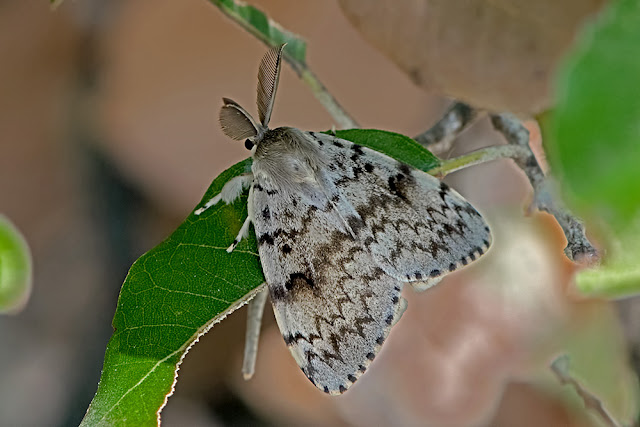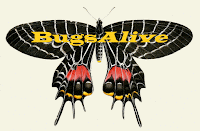Lymantria dispar - the Gypsy Moth
Written and photographed by Tim Stratford
Introduction
During a recent trip to the Ardéche region of southern France I was able to witness first hand a major part of the life cycle of the tussock moth Lymantria dispar. Every so many years there is an 'explosion' in the population of this moth and 2018 was one such year. There were caterpillars everywhere I went. It was not unusual for one to land on my head after it had lost its grip in the tree above and I soon got used to the constant rain of frass pellets. The caterpillars were crawling all over the veranda of my chalet and some even ventured inside. Because the campsite where I was staying was surrounded by trees I was able to study them in some detail within their natural environment. The only part of the life cycle that I did not witness was the actual laying of eggs.
Lymantria dispar, also known as the Gypsy Moth, is believed to have originated in Japan and Korea. Its invasive nature led to its spread westwards to populate other parts of Asia, much of Europe, and also North-west Africa. Like other moths in the Lymantriidae family, adult Gypsy Moths do not feed but their larvae are voracious feeders and can become serious pests stripping the leaves off huge areas of woodland. This happened in North America where the species was first introduced in the 19th century by a French researcher who mistakenly thought he could cross it with Bombyx mori to obtain a silk-producing hybrid that was stronger than the silkworm. The larvae of Lymantria dispar will eat the leaves from a wide range of trees but their favourite is the oak and they became the main defoliator of oak groves in the USA and Canada.
In its natural environment, the species has developed in harmony with numerous predators and plays its part in the balance of nature. It serves as prey for such animals as predatory and parasitic insects (e.g. wasps, ground beetles, etc.), spiders, birds, and small mammals such as mice, shrews, and squirrels. These predators usually keep the species in check, thus avoiding the large-scale damage caused in North America where there were no such established controls.
In this article I will set out all the information that I have learned during my own studies in 2018 together with data from other researchers. My observations were of the European species and so most of the information below relates to that particular subspecies although reference is made to the Asiatic form where appropriate.
Taxonomy
Animalia - Arthropoda - Insecta - Lepidoptera - Erebidae - Lymantriinae - Lymantria - dispar (Linnaeus, 1758)
Common Names
Preferred - Gypsy Moth France - Bombyx disparate; Spongieuse Netherlands - Zigeuner mot
Norway - Løvstraesnonne Germany - Schwammspinner; Zigeunermotte Sweden - Lövskogsnunna
Turkey - kir tirtili Japan - マイマイガ (maimaiga) Romania - Gubar
Finland - lehtinunna Spain - lagarta peluda de los encinares Korea - 집시 나방
Italy - bombice dispari Russia - Shelkopryad neparniy
Morphology
Lymantria dispar is a member of the Lymantriidae family in the insect order of Lepidopera (butterflies and moths). Lymantriidae includes around 350 known genera and over 2,500 known species that are found all over the world, in every continent except Antarctica. The Gypsy Moth however, is limited to the palearctic zone as it seems intolerant of the extremes of heat and cold. The Palearctic includes the regions of Europe, Asia north of the Himalayan foothills, north-western Africa, and the northern and central parts of the Arabian Peninsula.
The Gypsy Moth is sexually dimorphic and the two sexes are very different. The male is greyish-brown with dark brown and black zigzag markings (the Japanese subspecies, L.d.japonica, is very dark brown). They have a wingspan averaging around 30-35mm and are very active fliers. The body is a similar colour to the wings and is quite slender. It has long plumose antennae.
The female is much larger with a wingspan of up to 70mm and is white in colour. It too has dark brown or black zigzag markings but fewer than the male and the antennae are short. Her abdomen is white with yellowish hairs and is distended with an egg mass. In Europe the female is flightless. Although they have large wings, the musculature is not developed. The Asian subspecies however is able to fly. Neither sex eats and the life expectancy is short. They are diurnal which means that they fly mostly during the daylight hours.
Life History
The pellet-like eggs, around 1mm in diameter, are laid in clusters of up to 1000 eggs or more. These clusters can measure up to 40mm long by 20mm wide and are covered by a dense coating of yellowish hair-like setae sloughed-off from the females abdomen. The eggs are usually found on the trunk or lower branches of trees but sometimes also on walls, fences, or other sheltered locations. There is only one generation per year and the egg is the overwintering stage which lasts approximately nine months. The embryonic development takes place immediately after laying, but the small caterpillar formed inside then undergoes a diapause which lasts until the following spring. Eggs can withstand freezing temperatures and in fact the longer they are exposed to sub-zero conditions means the less heat required for them to hatch in the Spring.
The eggs hatch from early spring to mid-May and coincides with the budding of most hardwood trees. After hatching the larvae go through five or six instars depending on their sex. It is five for males and six for females. The first instar is about 3mm long but by the end of the final instar the males have grown to around 40-50mm and the females to 60-70mm. The first instar is grey/black in colouration but the later instars are more colourful with black, yellow, blue, and red patterns. All the instars are hairy and there can be variation in the colour of the head, thorax, abdomen, and hair. Older larvae can be identified by the presence of four or five pairs of raised blue spots followed by six pairs of raised brick-red spots along their backs.
The larval duration for females is up to 60 days and for males it is 40-50 days. These periods are variable and probably depend on a number of external factors including weather and food supply. An interesting observation that I made in the Ardeche was that some of the larvae had difficulty in moulting between instars and in some cases this led to their death. I am not sure if this is normal or if it has been observed elsewhere.
The larvae are highly polyphagous and feed on a wide variety of different tree species. Normally, the first three instars feed during the day and from the fourth instar onwards they feed at night. However, when there is a high density outbreak feeding continues day and night. The final instars are voracious feeders and research has concluded that, on average, a single larva consumes a total of around one cubic metre of foliage during its lifetime. In the Ardeche they were mostly feeding on the native Quercus ilex which grows wild over a large swathe of the plateau above the gorge.
Fig.1 below is a list of just some of the host plants used by the larvae of Lymantria dispar but they will eat virtually anything except maybe Olive and Fig trees. Click to enlarge.
After the extensive feeding period the larvae reach maturity between mid-June and early July and then enter the pupal stage. They pupate in a variety of sheltered locations including crevices in tree bark, under branches, on rock, or even in leaf litter on the ground where they are much more susceptible to predation. In the Ardeche they mainly used leaves on the host tree to create a loose cocoon held together by silk strands or found a suitable crevice in the bark where they again secured themselves with silk. Male pupae average 20-30mm in length while females are again larger at 30-40mm.
The pupation period lasts up to 15 days for males and just 10-12 days for females. The pupae are quite distinctive being dark brown in colour with golden hairs protruding at random around the pupal case.
On emergence the males fly around rapidly in the search for females. The flightless females crawl to an elevated place, usually the tree trunk, but not far from where they pupated and produce a pheromone that attracts the males. Males are capable of mating several times but females usually only mate once. Immediately after mating, the female lays her eggs without moving far from the spot where she has spent her entire adult life.
Natural Enemies
Extensive studies have taken place on the natural enemies of Lymantria dispar, mainly as part of biological control programmes. There are numerous parasitoids that attack both the eggs, larvae and pupa. The young caterpillars are parasitized by braconid wasps, whose larvae develop inside the caterpillar leading to its death. The parasitoid larva then leaves the remains of the caterpillar to pupate nearby. In addition, older caterpillars and pupae are parasitized by tachinid flies. Birds, spiders, small mammals (such as mice, shrews and squirrels) and invertebrates like beetles are all important predators. I saw quite a few of the carabid beetle Calosoma sycophanta, appropriately known as the caterpillar hunter, in the area of my study in France. This attractive beetle is a major predator of Lymantria dispar caterpillars both in its adult and larval forms.
Conclusion
Observing the various stages in the development of this species was fascinating. Although they are undoubtedly a threat to woodland during a major 'invasion', the trees usually recover the following year unless some other factor, like drought, further damages the already weakened trees. The gypsy moth is likely to eventually occupy all portions of the temperate world where oaks and other suitable host plants occur. The broad range of host plants that it utilizes and its high reproductive rate combine to make this insect a very successful invader of many types of forest. Although the females' inability to fly limits its advancement to a certain extent the species has another unique way of dispersal. The first instars suspend themselves from silk threads which eventually break and the wind then carries them to new feeding grounds. This does not occur in later instars but they do crawl over ground from tree to tree.
All stages in the life cycle of this species are most interesting to observe. As moths the adults are not unattractive, the clown-faced larvae are quite appealing, and the pupae are minature works of art.
Further reading
BENOIT, P.; LACHANCE, D., 1990: Gypsy moth in Canada: Behavior and control. Information Report DPC-X-32, Forestry Canada Ottawa:1–22.
HAJEK, A.E., 1997: Fungal and viral epizootics in gypsy moth (Lepidoptera: Lymantriidae) populations in central New York. Biol.Control 10: 58–68.
HÉRARD, F.; Le Bombyx disparate, Lymantria dispar L.(Lepidoptera, Lymantriidae). European Biological Control Laboratory, St-Gély-du-Fesc, France: 1-8.
KULA, E.; PESLOVA, A.; MARTINEK, P.; MAZAL, P. 2013: The Development of Caterpillars of Gypsy Moth (Lymantria dispar L.) Feeding on Food Affected by Nitrogen. Izvorni znanstveni članci – Original scientific papers Šumarski list, 1–2: 51–60
McMANUS, M.; CSÓKA, G., 2007: History and impact of gypsy moth in North America and comparison to recent outbreaks in Europe. Acta Silv. Lign. Hungary, Budapest., 3: 47–64.
NIERHAUS-WUNDERWALD, D.; WERMELINGER, B. 2001: Le bombyx disparate (Lymantria dispar L.). Institut fédéral de recherches WSL, Birmensdorf, Switzerland: 1-8.
WULK, A.; GRASER, E., 1996: Gypsy moth outbreaks in Germany and neighboring countries. Nachr.bl. Dtsch. Pflanzenschutzd. 48, 12: 265–269.
During a recent trip to the Ardéche region of southern France I was able to witness first hand a major part of the life cycle of the tussock moth Lymantria dispar. Every so many years there is an 'explosion' in the population of this moth and 2018 was one such year. There were caterpillars everywhere I went. It was not unusual for one to land on my head after it had lost its grip in the tree above and I soon got used to the constant rain of frass pellets. The caterpillars were crawling all over the veranda of my chalet and some even ventured inside. Because the campsite where I was staying was surrounded by trees I was able to study them in some detail within their natural environment. The only part of the life cycle that I did not witness was the actual laying of eggs.
Lymantria dispar, also known as the Gypsy Moth, is believed to have originated in Japan and Korea. Its invasive nature led to its spread westwards to populate other parts of Asia, much of Europe, and also North-west Africa. Like other moths in the Lymantriidae family, adult Gypsy Moths do not feed but their larvae are voracious feeders and can become serious pests stripping the leaves off huge areas of woodland. This happened in North America where the species was first introduced in the 19th century by a French researcher who mistakenly thought he could cross it with Bombyx mori to obtain a silk-producing hybrid that was stronger than the silkworm. The larvae of Lymantria dispar will eat the leaves from a wide range of trees but their favourite is the oak and they became the main defoliator of oak groves in the USA and Canada.
In its natural environment, the species has developed in harmony with numerous predators and plays its part in the balance of nature. It serves as prey for such animals as predatory and parasitic insects (e.g. wasps, ground beetles, etc.), spiders, birds, and small mammals such as mice, shrews, and squirrels. These predators usually keep the species in check, thus avoiding the large-scale damage caused in North America where there were no such established controls.
In this article I will set out all the information that I have learned during my own studies in 2018 together with data from other researchers. My observations were of the European species and so most of the information below relates to that particular subspecies although reference is made to the Asiatic form where appropriate.
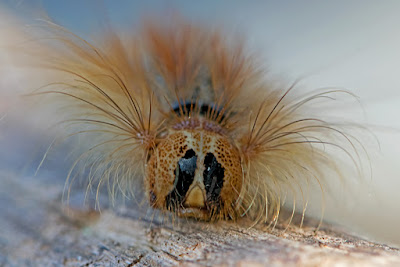 |
| Anteriorly the Gypsy Moth caterpillar looks rather clown-like |
Taxonomy
Animalia - Arthropoda - Insecta - Lepidoptera - Erebidae - Lymantriinae - Lymantria - dispar (Linnaeus, 1758)
Common Names
Preferred - Gypsy Moth France - Bombyx disparate; Spongieuse Netherlands - Zigeuner mot
Norway - Løvstraesnonne Germany - Schwammspinner; Zigeunermotte Sweden - Lövskogsnunna
Turkey - kir tirtili Japan - マイマイガ (maimaiga) Romania - Gubar
Finland - lehtinunna Spain - lagarta peluda de los encinares Korea - 집시 나방
Italy - bombice dispari Russia - Shelkopryad neparniy
Morphology
Lymantria dispar is a member of the Lymantriidae family in the insect order of Lepidopera (butterflies and moths). Lymantriidae includes around 350 known genera and over 2,500 known species that are found all over the world, in every continent except Antarctica. The Gypsy Moth however, is limited to the palearctic zone as it seems intolerant of the extremes of heat and cold. The Palearctic includes the regions of Europe, Asia north of the Himalayan foothills, north-western Africa, and the northern and central parts of the Arabian Peninsula.
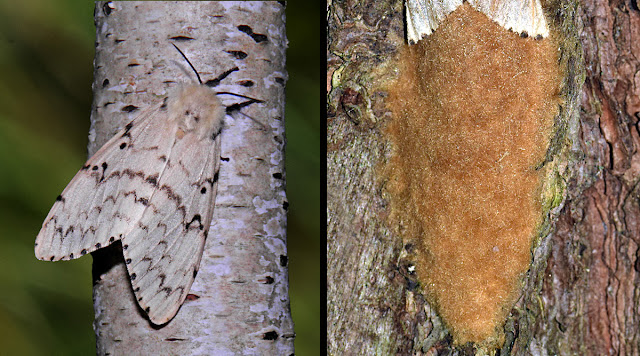 |
| LEFT: Dorsal view of a female RIGHT: egg cluster covered in hair-like setae from the females abdomen |
The female is much larger with a wingspan of up to 70mm and is white in colour. It too has dark brown or black zigzag markings but fewer than the male and the antennae are short. Her abdomen is white with yellowish hairs and is distended with an egg mass. In Europe the female is flightless. Although they have large wings, the musculature is not developed. The Asian subspecies however is able to fly. Neither sex eats and the life expectancy is short. They are diurnal which means that they fly mostly during the daylight hours.
Life History
The pellet-like eggs, around 1mm in diameter, are laid in clusters of up to 1000 eggs or more. These clusters can measure up to 40mm long by 20mm wide and are covered by a dense coating of yellowish hair-like setae sloughed-off from the females abdomen. The eggs are usually found on the trunk or lower branches of trees but sometimes also on walls, fences, or other sheltered locations. There is only one generation per year and the egg is the overwintering stage which lasts approximately nine months. The embryonic development takes place immediately after laying, but the small caterpillar formed inside then undergoes a diapause which lasts until the following spring. Eggs can withstand freezing temperatures and in fact the longer they are exposed to sub-zero conditions means the less heat required for them to hatch in the Spring.
The eggs hatch from early spring to mid-May and coincides with the budding of most hardwood trees. After hatching the larvae go through five or six instars depending on their sex. It is five for males and six for females. The first instar is about 3mm long but by the end of the final instar the males have grown to around 40-50mm and the females to 60-70mm. The first instar is grey/black in colouration but the later instars are more colourful with black, yellow, blue, and red patterns. All the instars are hairy and there can be variation in the colour of the head, thorax, abdomen, and hair. Older larvae can be identified by the presence of four or five pairs of raised blue spots followed by six pairs of raised brick-red spots along their backs.
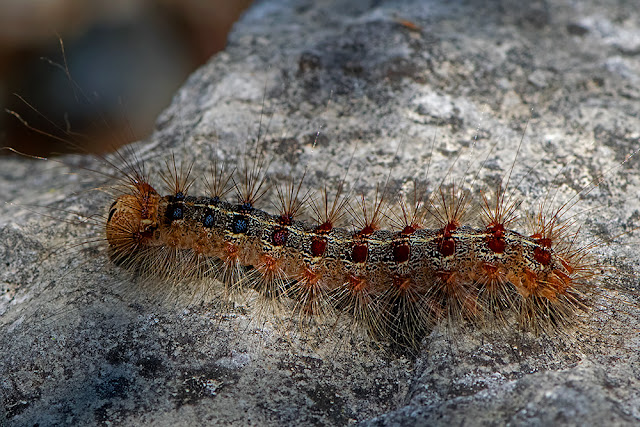 |
| Mature larva. The last pair of blue spots appears red on this specimen |
The larval duration for females is up to 60 days and for males it is 40-50 days. These periods are variable and probably depend on a number of external factors including weather and food supply. An interesting observation that I made in the Ardeche was that some of the larvae had difficulty in moulting between instars and in some cases this led to their death. I am not sure if this is normal or if it has been observed elsewhere.
The larvae are highly polyphagous and feed on a wide variety of different tree species. Normally, the first three instars feed during the day and from the fourth instar onwards they feed at night. However, when there is a high density outbreak feeding continues day and night. The final instars are voracious feeders and research has concluded that, on average, a single larva consumes a total of around one cubic metre of foliage during its lifetime. In the Ardeche they were mostly feeding on the native Quercus ilex which grows wild over a large swathe of the plateau above the gorge.
Fig.1 below is a list of just some of the host plants used by the larvae of Lymantria dispar but they will eat virtually anything except maybe Olive and Fig trees. Click to enlarge.
After the extensive feeding period the larvae reach maturity between mid-June and early July and then enter the pupal stage. They pupate in a variety of sheltered locations including crevices in tree bark, under branches, on rock, or even in leaf litter on the ground where they are much more susceptible to predation. In the Ardeche they mainly used leaves on the host tree to create a loose cocoon held together by silk strands or found a suitable crevice in the bark where they again secured themselves with silk. Male pupae average 20-30mm in length while females are again larger at 30-40mm.
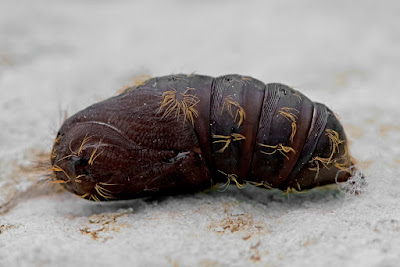 |
| Close-up of the pupa of Lymantria dispar |
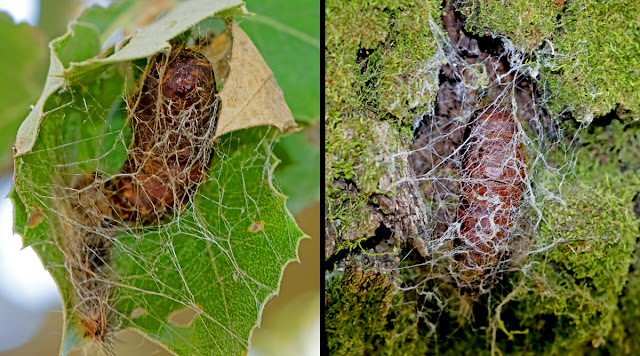 |
| pupa within a loose leaf cocoon a pupa secured into tree bark with silk |
The pupation period lasts up to 15 days for males and just 10-12 days for females. The pupae are quite distinctive being dark brown in colour with golden hairs protruding at random around the pupal case.
On emergence the males fly around rapidly in the search for females. The flightless females crawl to an elevated place, usually the tree trunk, but not far from where they pupated and produce a pheromone that attracts the males. Males are capable of mating several times but females usually only mate once. Immediately after mating, the female lays her eggs without moving far from the spot where she has spent her entire adult life.
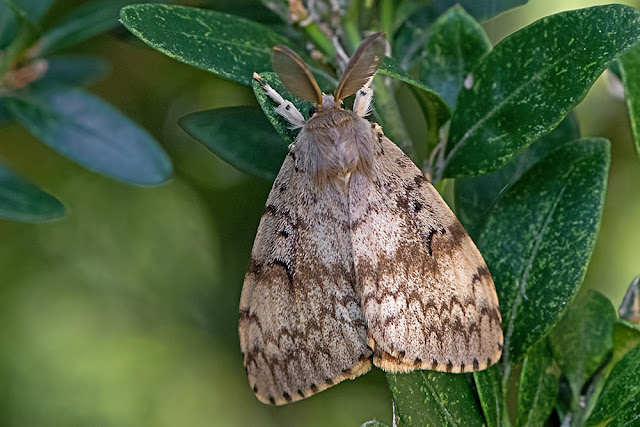 |
| Dorsal view of a newly emerged male Lymantria dispar |
Natural Enemies
Extensive studies have taken place on the natural enemies of Lymantria dispar, mainly as part of biological control programmes. There are numerous parasitoids that attack both the eggs, larvae and pupa. The young caterpillars are parasitized by braconid wasps, whose larvae develop inside the caterpillar leading to its death. The parasitoid larva then leaves the remains of the caterpillar to pupate nearby. In addition, older caterpillars and pupae are parasitized by tachinid flies. Birds, spiders, small mammals (such as mice, shrews and squirrels) and invertebrates like beetles are all important predators. I saw quite a few of the carabid beetle Calosoma sycophanta, appropriately known as the caterpillar hunter, in the area of my study in France. This attractive beetle is a major predator of Lymantria dispar caterpillars both in its adult and larval forms.
 |
| Calosoma sycophanta is a major larva predator |
Conclusion
Observing the various stages in the development of this species was fascinating. Although they are undoubtedly a threat to woodland during a major 'invasion', the trees usually recover the following year unless some other factor, like drought, further damages the already weakened trees. The gypsy moth is likely to eventually occupy all portions of the temperate world where oaks and other suitable host plants occur. The broad range of host plants that it utilizes and its high reproductive rate combine to make this insect a very successful invader of many types of forest. Although the females' inability to fly limits its advancement to a certain extent the species has another unique way of dispersal. The first instars suspend themselves from silk threads which eventually break and the wind then carries them to new feeding grounds. This does not occur in later instars but they do crawl over ground from tree to tree.
All stages in the life cycle of this species are most interesting to observe. As moths the adults are not unattractive, the clown-faced larvae are quite appealing, and the pupae are minature works of art.
Further reading
BENOIT, P.; LACHANCE, D., 1990: Gypsy moth in Canada: Behavior and control. Information Report DPC-X-32, Forestry Canada Ottawa:1–22.
HAJEK, A.E., 1997: Fungal and viral epizootics in gypsy moth (Lepidoptera: Lymantriidae) populations in central New York. Biol.Control 10: 58–68.
HÉRARD, F.; Le Bombyx disparate, Lymantria dispar L.(Lepidoptera, Lymantriidae). European Biological Control Laboratory, St-Gély-du-Fesc, France: 1-8.
KULA, E.; PESLOVA, A.; MARTINEK, P.; MAZAL, P. 2013: The Development of Caterpillars of Gypsy Moth (Lymantria dispar L.) Feeding on Food Affected by Nitrogen. Izvorni znanstveni članci – Original scientific papers Šumarski list, 1–2: 51–60
McMANUS, M.; CSÓKA, G., 2007: History and impact of gypsy moth in North America and comparison to recent outbreaks in Europe. Acta Silv. Lign. Hungary, Budapest., 3: 47–64.
NIERHAUS-WUNDERWALD, D.; WERMELINGER, B. 2001: Le bombyx disparate (Lymantria dispar L.). Institut fédéral de recherches WSL, Birmensdorf, Switzerland: 1-8.
WULK, A.; GRASER, E., 1996: Gypsy moth outbreaks in Germany and neighboring countries. Nachr.bl. Dtsch. Pflanzenschutzd. 48, 12: 265–269.

